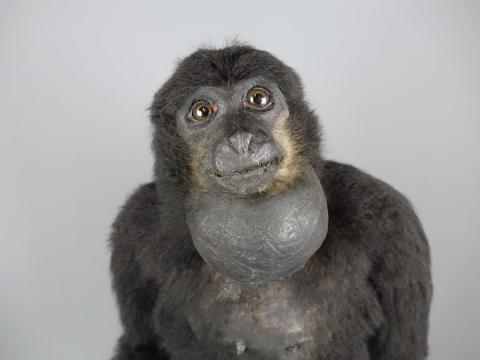
Musealia - the Siamang, Forest Acrobat
Every month, Sorbonne University introduces its community and the general public to an object from its heritage collections.
This month, discover a siamang specimen preserved in the zoology collection. Stuffed and mounted in the 19th century in a bipedal position and leaning on a stick, this monkey is in fact one of the animals best adapted to rapid brachiation* at the top of forests.
The Musealia cycle is run by the Sorbonne University Library, and in particular by its Heritage Centre.
The Siamang
Forgotten in storage for many years, a mounted monkey suddenly aroused interest following the move of the zoology collection to a new location. The siamang, a related species of gibbons, lives in the canopy of the tropical forests of Southeast Asia.
The knowledge of the existence of the siamang was late in Europe, and it was Etienne Geoffroy Saint-Hilaire and Frédéric Cuvier who first spoke of it in 1821. They both thought that it was probably a type of gibbon, but certain features, such as the direction of the forearm hair and the existence of a large laryngeal pocket, brought the species closer to the orangutan. The only distinctive feature was the joining of the index and middle fingers of the feet by a membrane down to the last phalanx, which is why Syndactyl was the first name proposed for the species.
The origin of the specimen at Sorbonne University was unknown. Fortunately, a note found in the National Archives revealed the missing information. In 1826, the Faculty of Sciences paid 120 francs for the purchase of a "mounted syndactyl". The author was Florent Prévost, the first taxidermist at the Sorbonne.
The naturalization of the skin, in a bipedal position and leaning on a stick, is strongly reminiscent of Buffon's jocko.

The description of the behavior of siamangs that Geoffroy Saint-Hilaire and Cuvier made in their book was:
"(...) Their bodies, too high and too heavy for their short and slender thighs, bend forward, and, with their two arms acting as stilts, they move forward in jerks."
A very sad portrait for one of the animals best adapted to the rapid brachiation at the top of the forests! Obviously, in the 1820s, the naturalist approach had not yet entered the study of animals at university level...
By Santiago Aragon, MCU and head of the zoology collection at Sorbonne University.
*Brachiation: the manner in which primates swing from tree limb to tree limb using only their arms.
Technical Data Sheet
• Name/Type: Naturalized Siamang (Symphalangus syndactylus)
• Inventory Number: Reserve-421
• Description: Antique taxidermy on wooden board (W. 50 cm; H. 95 cm; D. 55 cm)
• Date: 1826
• Place of conservation: Zoology Collection
Bibliography
• Etienne GEOFFROY SAINT-HILAIRE et Frédéric CUVIER, "Le Siamang" dans Etienne GEOFFROY SAINT-HILAIRE et Frédéric CUVIER, Histoire naturelle des mammifères […], Paris, Lasteyrie, 1821.
• Santiago ARAGON, "Collections pédagogiques universitaires et construction de savoirs naturalistes", dans Dominique JUHE-BEAULATON, Vincent LEBLAN (sous la dir.), Le spécimen et le collecteur. Savoirs naturalistes, pouvoirs et altérités (XVIIIe-XXe siècles), Paris, Muséum national d’Histoire naturelle, 2018, pp. 250-275 (Archives ; 27).
